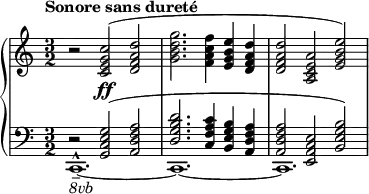Parallel harmony
In music, parallel harmony, also known as harmonic parallelism, harmonic planing or parallel voice leading, is the parallel movement of two or more melodies (see voice leading).
Illustrative example

Lines with parallel harmony can be viewed as a series of chords with the same intervallic structure. Parallel means that each note within the chord rises or falls by the same interval.
Examples from works



Prominent examples include:
- Claude Debussy's Beau soir (1880), Prélude à l'après-midi d'un faune (1894), Nocturnes (1899), La Mer (1905), La cathédrale engloutie, "Voiles", "Feuilles mortes"
- Maurice Ravel's Daphnis and Chloë Suite No. 2 (1913), "Menuet" from Le Tombeau de Couperin
- Erik Satie's Le Fils des étoiles (1892)
- Igor Stravinsky's The Rite of Spring (1913)
- Olivier Messiaen's music features abundant planing
- Richard Strauss's Elektra (1909)
- Arnold Schoenberg's Pierrot lunaire, "Columbine" (1914)
- William Schuman's Three Score Set for Piano (1944)
- John Williams's "Rebel Fanfare" from Star Wars
In the Schuman example (Three Score Set for Piano), the inversions of the chords suggest a bichordal effect.[2]
In the example to the right, we see a series of quartal chords in parallel motion, in which the intervallic relationship between each consecutive chord member, in this case a minor second, is consistent. Each note in the chord falls by one semitone in each step, from F, B♭, and E♭ in the first chord to D, G, and C in the last.
See also
References
- Cope, David (2000). New Directions in Music, p. 6. ISBN 1-57766-108-7.
- Kliewer, Vernon (1975). "Melody: Linear Aspects of Twentieth-Century Music", Aspects of Twentieth-Century Music, pp. 332–333. Wittlich, Gary (ed.). Englewood Cliffs, New Jersey: Prentice-Hall. ISBN 0-13-049346-5.
